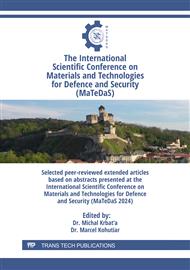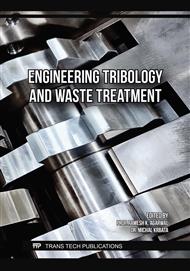[1]
Calabokis, O. P., Nuñez de la Rosa, Y., Borges, P. C., & Cousseau, T. Effect of an Aftermarket Additive in Powertrain Wear and Fuel Consumption of Small-Capacity Motorcycles: A Lab and Field Study. Lubricants, 10(7), (2022) 143.
DOI: 10.3390/lubricants10070143
Google Scholar
[2]
Ouyang, T., Huang, H., Zhang, N., Mo, C., & Chen, N. A model to predict tribo-dynamic performance of a spur gear pair. Tribology International, 116, (2017) 449-459.
DOI: 10.1016/j.triboint.2017.08.005
Google Scholar
[3]
Marjanovic, N., Ivkovic, B., Blagojevic, M., & Stojanovic, B. Experimental determination of friction coefficient at gear drives. Journal of the Balkan Tribological Association, 16(4), (2010) 517–526.
Google Scholar
[4]
Adebogun, A., Hudson, R., Breakspear, A., Warrens, C., Gholinia, A., Matthews, A., & Withers, P. Industrial gear oils: tribological performance and subsurface changes. Tribology letters, 66, (2018) 1-13.
DOI: 10.1007/s11249-018-1013-2
Google Scholar
[5]
Wang, Zongzheng, et al. "Unified gear tribo-dynamic of transient mixed lubrication and nonlinear dynamics and its experimental validation." Mechanical Systems and Signal Processing 223 (2025): 111860.
DOI: 10.1016/j.ymssp.2024.111860
Google Scholar
[6]
Fernandez-Del-Rincon, A., Diez-Ibarbia, A., & Theodossiades, S. Gear transmission rattle: Assessment of meshing forces under hydrodynamic lubrication. Applied Acoustics, 144, (2019) 85-95.
DOI: 10.1016/j.apacoust.2017.04.001
Google Scholar
[7]
Saucedo-Dorantes, J. J., Delgado-Prieto, M., Osornio-Rios, R. A., & Romero-Troncoso, R. D. J. Diagnosis methodology for identifying gearbox wear based on statistical time feature reduction. Proceedings of the Institution of Mechanical Engineers, Part C: Journal of Mechanical Engineering Science, 232(15), (2018) 2711-2722.
DOI: 10.1177/0954406217721727
Google Scholar
[8]
BLAU, P. J. Tribosystem analysis: a practical approach to the diagnosis of wear problems. Boca Raton: CRC Press,Taylor & Francis Group, ISBN 978-1-4987-0050-4, 2016.
DOI: 10.1007/s11249-017-0919-4
Google Scholar
[9]
Bhat, J. S., & Sonawane, B. U. Condition monitoring of worm gearbox through oil analysis. In Recent Trends in Engineering Design: Select Proceedings of ICAST 2020 (2021) 289-296.
DOI: 10.1007/978-981-16-1079-0_30
Google Scholar
[10]
K. Singh, R.K. Khatirkar, S. G. Sapate, Microstructure evolution and abrasive wear behavior of D2 steel, Wear 328 (2015) 206-216.
DOI: 10.1016/j.wear.2015.02.019
Google Scholar
[11]
ADETUNLA, Adedotun, et al. The advances of tribology in materials and energy conservation and engineering innovation. In: E3S Web of Conferences. EDP Sciences, (2023) p.01014.
DOI: 10.1051/e3sconf/202339101014
Google Scholar
[12]
Batchelor, A. W., & Stachowiak, G. W. Tribology in materials processing. Journal of Materials Processing Technology, 48(1-4), (1995) 503-515.
DOI: 10.1016/0924-0136(94)01689-x
Google Scholar
[13]
Totten, G. E. (Ed.). (2017). Friction, lubrication, and wear technology. ASM international, Vol. 18. (2017) 454-468.
Google Scholar



